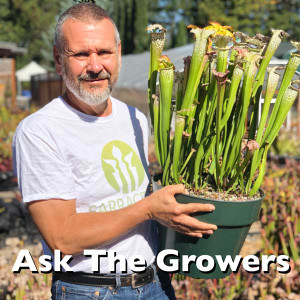March 2, 2023
Q/A #44 - Nepenthes Leaves Are Turning Red and Dying
QUESTION:
I have a Nepenthes Lady Luck (N. ampullaria x ventricosa). I had it for 6 months, using distilled water, in south facing window in Denver, so sun might be more intense since we are at a high altitude. The leaves are turning reddish or brown spots and then dying. What's causing it?



RESPONSE BY JEFF DALLAS:
Your plant looks healthy. What you're seeing is an old leaf on the lower portion of th plant dying off; part of the normal growth cycle. Just cut it off. Same with any of the brown ones. In nature Nepenthes are vines, so you will see the stems elongate and old leaves will die from the bottom just like you are seeing. The upper portion of the plant looks healthy.
Your sun is probably just right in a south window. Glass blocks 80% of UV light, and if they are newer or Argon filled insulating windows, they are probably 100% UV blocking. Too much sun is very rarely an issue with carnivorous plants, and you would see reddish leaves if they were getting close to excessive sun. In my experience, windows are almost never too bright indoors for Nepenthes. However, you might monitor temperatures in the window. Since it's still winter, temperatures getting too low at night (like 40's to low 50's) can be a problem for some Nepenthes.
One other thing I did notice in the photos was a leaf on one plant developing a brown patch in the middle of the leaf. This can develop if the soil is excessively wet. Be sure to only top-water the plant, and not allow it to sit in a water tray for long periods. ( I couldn't see what kind of tray it had.) The soil of Nepenthes should be moist, but not waterlogged.
• The original question and response have been edited for publication.
• With a database of thousands of questions, we will post a Q&A every few days or so.
• To search for similar posts, click on a hashtag below or use the site's search function.
• To submit a carnivorous plant question, visit Ask the Growers.

